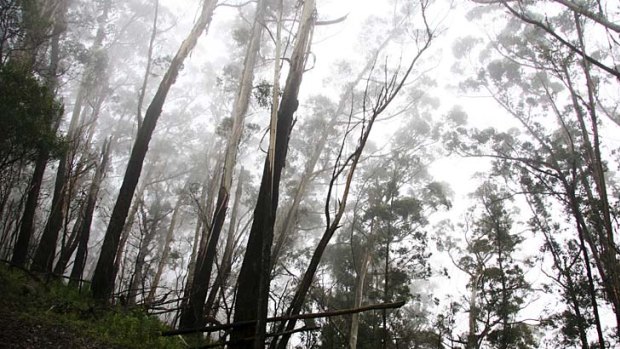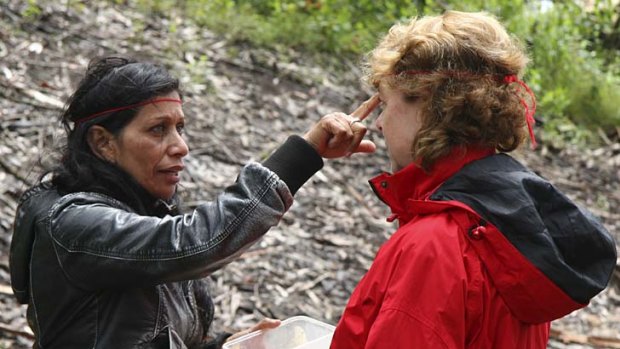This was published 12 years ago
The mist and the mystical
Kerry van der Jagt escapes to mother mountain to contemplate life and some of its lessons.

Spiritual signpost ... Mount Gulaga is shrouded in a mist the Yuin people call a "possum cloak".Credit: Kerry van der Jagt
I'm standing in a clearing at the top of Mount Gulaga, eyes closed, as Aboriginal guide Lynne Thomas ties a piece of red twine around my forehead. Next she applies a daub of white ochre to my left temple and says: "This will help you see clearly." I open my eyes to find the world awash with a soft light. "And this is to help you listen," she says, applying a daub to my right temple. My mind now focused, the forest orchestra comes to life. Bellbirds and frogs erupt into song, their lusty calls contrasting with the murmur of the forest breathing all around me.
"This is to open your heart," she says, applying a dot to my third eye, in the middle of my forehead. My heart is still hammering from the three-hour climb but under her touch it begins to settle. It's been hammering erratically for a while now, after a tough couple of months of family health issues. And that's why I'm here with a group of my closest female friends: to climb the mountain the local Yuin people call the "mother mountain", a spiritual place of rebirth and healing. All is well now but I've been left with an instinctive desire to reorient myself with the earth.
"It doesn't matter who you are or where you are from," Thomas says. "We are all connected to the earth." Finally, she places a daub on my chin. "Only once you've looked and listened and opened your heart should you begin to speak."

Focus ... Aboriginal guide Lynne Thomas daubs ochre on a hiker's forehead.Credit: Kerry van der Jagt
One by one she performs the ceremony on each of us, before leading the way through a gap in the white ash trees as Aboriginal elder Vivienne Mason claps us in with her music sticks. In true Picnic at Hanging Rock style we are engulfed by a swirling mist as we step across the threshold and enter a world of soaring granite tors and animal-shaped boulders. When I look back I can't see where I've come from.
I first dreamt up this escapade 12 months earlier when I was on Montague Island volunteering on a Seabird Habitat Restoration Project organised by the NSW National Parks and Wildlife Service (NPWS). While pulling weeds, I noticed a pool of fresh water. "That water is from the tears from Mount Gulaga," said the national parks guide, pointing to the mountain on the mainland.
Like a bowerbird, I grabbed that shiny bit of information and held it for another day. A year later I'm back.
It's a fine spring morning when we set off for the 370-kilometre drive from Sydney to Mount Gulaga, near Narooma on the far south coast of NSW. With plenty of time for detours and distractions, we stop at Tuross Boatshed for fish and chips, Tilba Valley Wines for a case of shiraz, Central Tilba for cheese and, finally, Lyrebird Lodge, our home for the next two nights.
Early the next day we drive to Tilba Tilba to meet NPWS guide Kathryn Brown and Thomas. Protected as a national park since 2001, Mount Gulaga was handed back to its traditional Aboriginal owners in 2006. Today, it is jointly managed by NPWS and the Gulaga Board of Management, which consists of a majority of Yuin Aboriginal owners.
Over the course of the day, Brown and Thomas demonstrate the benefits of this dual partnership: Brown with her scientific knowledge and ability to recognise a stuttering frog or a barking owl at 10 paces; and Thomas, the custodian of so much local knowledge.
It's getting warm but a 15-minute walk along a farm track brings us to a dappled path in a lush and shady forest. With Thomas leading the way, we are soon engulfed by dense foliage, the trail leading us through bracken-covered gullies and stands of monkey gums.
In time we spread out, the girly giggles of the previous evening replaced by the need for quiet reflection. At this point we are oblivious to the precious gifts that lie ahead: friendships strengthened, priorities redefined, wisdom gained. Later, my friend Narelle tells me: "Learning about the Yuin rituals and beliefs has given me a valuable insight into the various stages of life we all pass through."
When we stop on a plateau to enjoy the coastal view, Thomas tells us about the Dreaming story of Mount Gulaga. Many thousands of years ago, Gulaga gave birth to two sons, Baranguba and Najanuga. Once Baranguba was old enough, he asked his mother if he could live in the ocean with the whales and dolphins. Gulaga agreed, so the young son swam out and turned into Montague Island. Her youngest son, who wanted to do the same but couldn't swim, was instructed to stay close and sit at her feet, eventually becoming the smaller mountain, known as Little Dromedary.
Legend has it that Baranguba (Montague Island) is still joined to Gulaga by an umbilical cord that runs under the sea. Brown reminds us this isn't as fanciful as it sounds, since Mount Gulaga is an ancient volcano with underground lava tubes. Thomas adds another layer to the story by telling us you can hear dolphins from the top of the mountain. "When I was a little girl, my father taught me to put my ear against holes in the rocks and to listen to the dolphins calling."
We continue on our way, passing the "grave of the unknown Chinaman", a legacy to the gold rush days and a reminder of the destruction the mining and forestry industries once brought to the mountain. As I climb higher, the magnetic pull of Gulaga becomes stronger, uplifting and energising me, until finally we reach the saddle where we are welcomed by Mason.
For years Yuin elders have been sharing their stories with visitors, teaching them how to respect the land. Tours were organised through word-of-mouth or the NPWS but with the development of a new draft management plan, the Gulaga Board of Management plan to endorse a range of cultural tours in the near future. In the meantime, all visitors are welcome to climb Mount Gulaga but the elders ask that you stay on the track as some places should not be visited without a Yuin custodian.
After the ochre ceremony, Thomas leads us into the sacred tors where we are quickly engulfed by a mist the Yuin people call a "possum cloak". The first rock we stop at is the "fertility" or "energising" rock. At Thomas's invitation, we kneel quietly and meditate before placing our hands on its well-worn surface. "Take your time and breathe it all in," she says. The pungent aroma of the soil blends easily with the sharp scent of lemon and eucalyptus.
As we continue, she talks about her father, "Guboo" Ted Thomas, a tribal elder and spiritual leader who often called the rocks their "cathedral".
"This is where I reconnect and feel the spirit of my ancestors," Thomas says, leading us to a gigantic, three-tiered tor. She explains that the bottom rock represents the past, the middle rock the present and the top one the future. "Everything is connected and is here for a reason."
She singles out details in the swirling blur of rocks and trees: a giant snake, a breaching whale and a maze where the spirit children play. Eventually, Thomas leads us to a dome-capped rock where she tells us it's time to use our third eye.
By staring until my eyes water, the picture sharpens, like a magic-eye image, to reveal a woman giving birth; an angelic face with closed eyes, upturned nose and a little chin peeks out between a hefty pair of thighs. "Men can only see a mushroom," Thomas says with a grin.
While other cultures talk about the birds and the bees, the Yuin people have long brought their boys and girls to the mountain for intimate lessons on life, love and loyalty. If there is a more perfect place to contemplate such wonders, I am yet to find it.
Thomas invites us to add a small rock to an ever-growing circle of rocks. "Gulaga will call you back," she says. "You are now connected to her forever."
The writer travelled with the assistance of NSW NPWS.
Trip notes
Getting there
Tilba Tilba is a five-hour drive south of Sydney. Follow the Princes Highway and take the Central Tilba turnoff, past Narooma.
Staying there
Lyrebird Lodge is a three-bedroom, self-contained cottage set in the foothills of Mount Gulaga, a 15-minute drive from the start of the walking track. It costs $450 a couple for two nights (minimum two-night stay), plus $40 an extra adult, a night. (02) 4476 3370, tilba.com.au/lyrebirdlodge.
Touring there
The Mount Gulaga walking track starts behind Pam's Store at Tilba Tilba. It is a steep track graded as "hard" and takes about five hours (11-kilometre return). (02) 4476 0800, environment.nsw.gov.au/nationalparks.
Three other things to do
1 Hang out with Australian sea lions and little penguins on Montague Island. Guided tours and overnight stays are available. montagueisland.com.au.
2 Walk the Bingi Dreaming Track in the Eurobodalla National Park, an inspiring coastal experience. environment.nsw.gov.au/nationalparks.
3 Visit Mumbulla Mountain in the Biamanga National Park, a sacred site for the initiation of Yuin men. environment.nsw.gov.au/nationalparks.
Sign up for the Traveller Deals newsletter
Get exclusive travel deals delivered straight to your inbox. Sign up now.